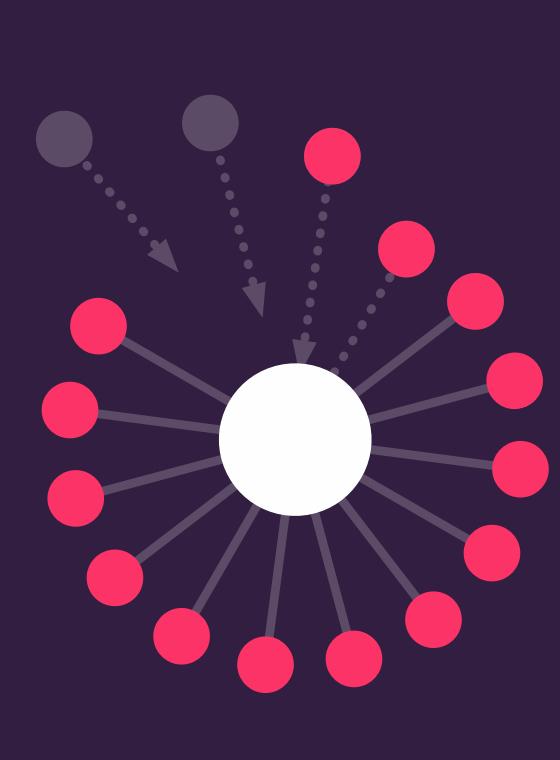
Kayla Lee
Contributor
Everybody in sales is familiar with the anxious thought, what should I write now? What will make them say yes?
Sales follow-up emails are an art. You can’t say too much, you can’t say too little when using a follow-up email format. The subject line is half the battle—and these follow-up messages are arguably the most important piece in getting a deal closed:
- 80% of sales require at least 5 follow-ups.
- 44% of reps give up after 1 follow up.
- Nearly 50% of reps make zero attempts to follow up.
We’re going to share our best strategies for creating killer sales follow-up emails that are proven to ease the pain and convert, including:
What's the anatomy of a good follow-up email?
There’s lots that goes into a good follow-up email. In this section, we’re going to cover the necessities and then talk about some good placeholders you can add to your templates to give your emails a personal touch for each send.
Make sure it’s well written.
For starters, it needs to be well written.
Good writing is important for any follow-up email, of course, but clearer sales emails can also help your prospects understand your product and its benefits.
So, have the best writer on your team put these emails together. Get them to proofread every message that incorporates the follow-up email format.
A good sales email isn’t too long, and it gets to the point. Put your emails into your CRM as templates so salespeople save time and don’t make writing errors.
Email templates are easy to set up in Gmail if you're using Copper as a CRM.

Pro-tip
Write emails that get results. 🚀
Join this sales email series boot camp to get tips delivered straight to your inbox.
If busy salespeople have to write emails from scratch, there's a higher chance of typos and other mistakes.
Talk about results as benefits.
Amateur reps are often under the impression that they’re selling a product or what a company does.
But, that’s not the case.
Top performers know that results sell things and should be referenced in follow-up emails. The best reps sell results and benefits, not products or services.
How do you write a results-based benefit? Write something tangible—numbers are best. You know what people love to buy? More money.
At the bottom of this post, there are some templates with placeholders for benefits. These are the types of phrases you should put into those placeholders:
- Our email tool will save the average exec 10 hours per week. (Time is money)
- You’ll see ROI within the first 2 weeks of implementing our service. (ROI is money)
- Our customers save an average of $5,000 per month after the first 2 months. (Money)

FREE EBOOK
More CRM tips 👇
Learn about other little-known ways you can use your CRM.
Warm things up.
Selling is cold at first. Always, even if you’re shaking hands for the first time at a networking event. In the same way that you’d build rapport with a drink and a handshake, build rapport via email.
Here are a few examples of how to start sales follow-up emails:
- "I notice we’ve got the same alma mater." (find similarities on LinkedIn)
- "I’m reaching out based on Jane’s referral, she’s a friend of mine." (referrals are super warm)
- Use friendly language: words like "she’s a friend of mine," "I’d love to," and "Hi" instead of "Hello" or "Dear...", and use first names instead of last.
End with a CTA.
If you don’t ask, you won’t get a yes. Make sure you end each email with a question. One of the best email CTAs is asking for a 5-minute call to discuss. There’s something about “5 minutes” that feels less intimidating than a 30-minute commitment.
When should you follow up?
Given that 30-50% of sales go to the vendor that responds first, you should follow up fast. There are many occasions that call for a quick follow-up email. Let’s take a look at a few of the most popular occasions. We’ll also share proven sales follow-up email templates and follow-up email samples with you.
After first contact
Lots of times, prospects like to ghost after your first call with them. Maybe they’ve realized they don’t want your product or service. Maybe they’ve just forgotten to follow up. Either way, there’s a great way to find out without being a pest.
A clever way to send a follow-up sales email after no response on your initial call is to send them a recap. I have a good friend who sells B2B payroll solutions—he’s a top seller at his company, and he swears by this.
He sends a brief note and calls the notes he sends “an Executive Summary.” He told me prospects really appreciate this, they feel taken care of, and typically this coaxes them out of their ghosting.
Here is a follow-up email sample:
Subject: question about our last call
Hi {{First Name}},
I’m just following up from our call. I wanted to share a summary of {{what you discussed}}. From our convo, I think we can really help you {{benefits you discussed}}.
See my notes attached. Do you have 5 minutes to go over these benefits?
{{Signature}}
Intro or referral email follow-up
This might seem obvious—but, it’s extremely important to follow up from a referral or introduction almost immediately. And, you must cc the person that referred/introduced you to the prospect. This will dramatically improve your open rates, especially if you follow the email template below.
Subject: referral from {{Referrer’s Name}}
Hi {{First Name}},
I’m reaching out based on {{Referrer’s Name}} recommendation that we connect. {{Referrer}} feels that we might be able to help each other since {{Reason for referral}}.
Do you have 5 minutes to chat this week?
{{Signature}}
Getting to the right person
You need to get past any gatekeepers and get to the decision maker as quickly as possible. Email is a great way to make that ask.
Subject: did I miss you?
Hi {{First Name}},
I’m following up from my last email—I didn’t hear back from anyone. Can you speak for 5 minutes this week about {{Top benefit your company can provide}}?
If you’re not the right person, can you tell me who is?
I really appreciate your time!
{{Signature}}
If they haven’t responded after initial contact
As mentioned above, 80% of sales require at least five follow-ups. Don’t be stressed if a prospect doesn’t respond to your initial follow-up or contact. The best thing to do is just to send them a nice reminder that you contacted them.
What I do is follow up with the exact text I sent the first time (so that the prospect doesn’t have to dig through their inbox to find what I said). Then, I add a review from a similar client. Like this sample email:
Subject: What {{Current Customer}} thought...
Hi {{First Name}},
I wanted to reach back out about {{insert content from the email you initially sent}}.
Check out what {{Current Customer}} had to say about this product
{{Insert glowing review from a customer that’s similar to the prospect}}.
Do you have 5 minutes in the next couple of days to follow-up on this?
{{Signature}}
This template typically lands me three meetings per week. (And, I get most of the meetings the third time I send it.)
Subject: some important notes
Hi {{First Name}},
I’m just following up from our call. I wanted to share a summary of {{what you discussed}}. From our convo, I think we can really help you {{benefits you discussed}}.
See my notes attached.
{{Signature}}
If they haven’t responded to your follow-ups
If they ghost your first follow-up email attempt, you need a second, more direct follow-up—with an email subject line that grabs attention and creates urgency, such as this sample email.
Subject: Question about {{something you’ve discussed}}
Hi {{Name}},
I’m reaching out to see if you’ve had time to think about how we can help you with {{something you’ve discussed}}?
If not, I’d love to hop on a 5-minute call and see if I can help you with {{problem you know this prospect likely has}}.
Do you have 5 minutes in the next couple of days?
{{Signature}}
When they asked you to contact them later
This happens all the time. Prospects say, “I’m in the middle of a big project, can you email me in a couple of weeks?” Or, “reach back out at the start of next quarter.”
So, what’s the best way to do that?
Subject: {{Your name}} from {{how you met}}
Hi {{First Name}},
I’m following up from {{how you met}}. You asked me to reach back out, so here I am!
Do you have 5 minutes in the next couple of days to discuss how I can help you {{Top benefit your company provides}}?
{{Signature}}
After an event trigger
Subject: Thanks for coming to {{event trigger}}!
Hi {{First Name}},
I wanted to thank you for {{event trigger}} and reach out to see if I can help you put {{resource}} to use?
Do you have 5 minutes in the next couple of days to go over how we could help you {{Top benefit your company provides}}?
{{Signature}}
The secret to sending efficient follow-up emails....
If you want to make the most of your follow-up efforts, you need templates to create a reliable flow of follow-up emails.
- Be ready with templates because 30-50% of sales go to the vendor that responds first
- Have templates prepared because, like we said above, most Americans can’t write
- If you’re not consistent, you won’t know what works and what doesn’t
You don’t want to waste a sales rep’s time—the more they’re typing, the less they’re selling. One way to try out email templates and use them to generate leads for your business is through a CRM.
It’s as easy as this:
1. Create a template. Here's how it looks in Copper:
2. Name your template and enter a subject line and description.
3. That’s it!
Put these sales follow-up templates to good use.
According to the Harvard Business Review, a few more follow-up attempts can increase responses that reps receive by 70%. So, don't wait to implement a follow-up strategy after writing an initial email. Make sure your emails:
- Are well written, aren’t too long, and talk about actual benefits.
- Have plenty of templates, because you’re likely going to need more than one follow-up to make a sale.
- Are integrated into your CRM, so you keep reps selling, not typing with email templates.
What are your best sales follow-up emails?










